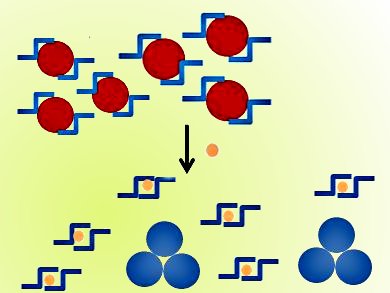Aydogan Ozcan, University of California, Los Angeles (UCLA), CA, USA, and colleagues developed a sensitive and cost-efficient smartphone-based device to easily measure levels of mercury(II) ions in water.
A device containing two disposable test tubes and two light-emitting diodes (LEDs) at 523 and 625 nm was attached to the built-in camera of a smart-phone. The test tubes contain gold nanoparticles (Au NPs) which are separated from each other by aptamers. When a water sample containing Hg2+ is added to one test tube, Hg2+ binds to the aptamers and the Au NPs start to clump. This causes the light they emit to shift from red to blue. Light of the LEDs is transmitted by the nanoparticle solutions towards the camera of the phone. A smartphone application for rapid digital image processing determines the Hg2+ concentration based on the color differences between the pictures of the two test tubes.
A limit of detection of ∼3.5 ppb was achieved; the maximum allowable level of Hg2+ in drinking water defined by the U.S. EPA is 2 ppb and by the WHO 6 ppb.
The researchers tested their device by measuring more than 50 samples collected from various sources including tap, river, lake, and ocean water samples.
- Detection and Spatial Mapping of Mercury Contamination in Water Samples Using a Smart-Phone,
QingshanWei, Richie Nagi, Kayvon Sadeghi, Steve Feng, Eddie Yan, So Jung Ki, Romain Caire, Derek Tseng, Aydogan Ozcan,
ACS Nano 2014.
DOI: 10.1021/nn406571t



